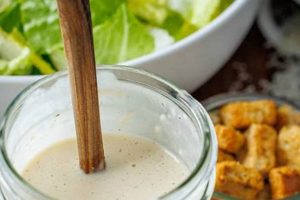A classic emulsion-based dressing, typically made with oil, vinegar, and egg yolks, often incorporates ingredients like Dijon mustard, garlic, herbs, and spices to achieve its rich, smooth texture and tangy flavor profile. Variations exist, substituting mayonnaise or sour cream for some of the oil, resulting in a thicker consistency and milder taste.
This style of dressing offers a versatile complement to a wide range of salads, particularly those featuring crisp lettuce greens, vegetables like tomatoes and cucumbers, or protein elements such as chicken or shrimp. Its popularity stems from the balance of creamy richness and piquant acidity, which enhances the flavors of the accompanying ingredients. Historically, emulsified dressings have roots in French culinary tradition, with variations evolving over time to suit diverse palates and ingredients.
Further exploration will cover specific ingredient combinations, detailed preparation methods, and practical tips for achieving the perfect emulsion, as well as suggestions for adapting this versatile dressing to diverse culinary applications. Nutritional information and potential allergen considerations will also be addressed.
Tips for Crafting Exceptional French Salad Dressing
Achieving a balanced and flavorful emulsion is key to a successful dressing. These tips offer guidance for optimal results.
Tip 1: Emulsion Stability: Gradual incorporation of oil into the vinegar-yolk mixture, whisking constantly, ensures a stable emulsion, preventing separation.
Tip 2: Flavor Enhancement: Freshly minced garlic and finely chopped herbs like chives or tarragon elevate the flavor profile, adding depth and complexity.
Tip 3: Acidity Adjustment: Balancing the acidity of the vinegar with a touch of sweetness, such as a pinch of sugar or a drop of honey, rounds out the flavor.
Tip 4: Ingredient Quality: Utilizing high-quality oils, like extra virgin olive oil, and fresh, free-range egg yolks contributes significantly to the overall quality of the dressing.
Tip 5: Seasoning Precision: Seasoning with salt and freshly ground black pepper should be done gradually and tasted throughout the process to achieve the desired balance.
Tip 6: Texture Variation: For a thicker dressing, incorporate small amounts of mayonnaise or sour cream while whisking continuously.
Tip 7: Storage: Refrigerate the prepared dressing in an airtight container for up to three days to maintain freshness and flavor.
By following these guidelines, one can consistently create a smooth, flavorful, and well-balanced dressing that complements a variety of salads and dishes.
These techniques provide a foundation for creating a dressing tailored to individual preferences and culinary needs. The following section offers concluding remarks and further resources.
1. Emulsion (stability)
Emulsion stability is paramount in crafting a successful creamy French salad dressing. A stable emulsion prevents the separation of oil and vinegar, ensuring a smooth, homogenous texture crucial for both visual appeal and palate satisfaction. This characteristic directly influences the dressing’s overall quality and enjoyment.
- Temporary Emulsions:
These emulsions, like a simple vinaigrette, require shaking before each use due to their inherent instability. Oil and vinegar quickly separate. While suitable for some dressings, a creamy French dressing necessitates a more stable form.
- Permanent Emulsions:
Permanent emulsions, as achieved with egg yolks or other emulsifying agents, bind oil and vinegar effectively, preventing separation. This stability is essential for the creamy, consistent texture characteristic of this dressing.
- Emulsifying Agents:
Egg yolks, containing lecithin, act as a binding agent, allowing oil and vinegar to coexist stably. Other emulsifiers, such as mustard, contribute to both stability and flavor complexity.
- Factors Affecting Stability:
Temperature fluctuations, excessive force during mixing, and ingredient ratios can influence emulsion stability. Careful attention to these details during preparation safeguards against separation.
A stable emulsion is the cornerstone of a creamy French salad dressing. By understanding the principles of emulsification and employing appropriate techniques, a luscious, homogenous dressing that clings beautifully to salad ingredients can be consistently achieved. This foundation ensures both visual appeal and a harmonious blend of flavors.
2. Flavor Balance
Flavor balance is essential for a successful creamy French salad dressing recipe. It distinguishes a truly enjoyable dressing from a mediocre one. A harmonious blend of tastes elevates the overall sensory experience, complementing the ingredients of the salad rather than overpowering them. Achieving this balance involves a careful interplay of different flavor components.
- Acidity:
Vinegar provides the essential acidic foundation of the dressing. Common choices include white wine vinegar, champagne vinegar, or even a touch of lemon juice. The level of acidity should be bright but not overpowering, creating a refreshing counterpoint to other flavors. Excessive acidity can make the dressing sharp and unpleasant.
- Richness:
The creamy element, derived from egg yolks, mayonnaise, or sour cream, contributes a rich mouthfeel and mellows the acidity. This richness should be balanced, not overly heavy, allowing the other flavors to shine through. Overly rich dressings can become cloying and mask the flavors of the salad ingredients.
- Sweetness:
A touch of sweetness can balance the acidity and enhance the overall flavor profile. A small amount of sugar, honey, or maple syrup can round out the sharpness of the vinegar. This element should be subtle, avoiding an overly sweet dressing that clashes with savory salad components.
- Savory Notes:
Savory elements, such as Dijon mustard, garlic, shallots, herbs, and spices, add depth and complexity to the dressing. Dijon mustard provides a subtle pungency, while garlic and shallots offer a savory bite. Fresh herbs, like chives, parsley, or tarragon, contribute aromatic complexity. The balance of these savory notes is crucial; too much can create an overpowering or unbalanced flavor profile.
The interplay of these four flavor componentsacidity, richness, sweetness, and savory notesdefines the character of a creamy French dressing. Achieving a harmonious balance among these elements is crucial for a dressing that enhances the overall salad experience, complementing the flavors of the other ingredients and creating a delightful culinary composition.
3. Ingredient Quality
Ingredient quality significantly impacts the final character of a creamy French salad dressing. Superior ingredients elevate the flavor profile, texture, and overall sensory experience. Substandard ingredients, conversely, can result in a dressing that lacks depth, complexity, and the desired creamy consistency. Understanding the role of each ingredient and selecting high-quality options is paramount for a truly exceptional dressing.
- Oil:
The choice of oil profoundly influences the dressing’s flavor and texture. Extra virgin olive oil, with its robust flavor and smooth texture, is a classic choice. However, other oils like avocado or grapeseed oil offer milder flavors and can be suitable alternatives. Avoid using oils with strong or overpowering flavors that might clash with the other ingredients. Quality oils contribute to a luscious mouthfeel and enhance the overall flavor profile.
- Vinegar:
Vinegar provides the necessary acidity that balances the richness of the oil and other ingredients. High-quality vinegars, such as white wine vinegar, champagne vinegar, or apple cider vinegar, possess nuanced flavors that complement the dressing. Avoid using distilled white vinegar, which can have a harsh, one-dimensional taste. The quality of the vinegar significantly affects the overall balance and complexity of the dressing.
- Eggs (or Emulsifying Agent):
When using eggs, fresh, high-quality eggs are essential for both flavor and emulsification. The yolks contain lecithin, a natural emulsifier that binds the oil and vinegar together, creating a stable and creamy dressing. If using an alternative emulsifier like mayonnaise, opt for a high-quality product made with good ingredients. The quality of the emulsifying agent directly affects the texture and stability of the dressing.
- Aromatics and Seasonings:
Freshly minced garlic, shallots, and high-quality herbs and spices contribute significantly to the flavor complexity of the dressing. Fresh herbs, rather than dried, offer a brighter, more vibrant flavor. Using high-quality spices, like freshly ground black pepper, ensures optimal flavor and aroma. These elements contribute depth and nuance to the final product.
The cumulative effect of using high-quality ingredients in a creamy French salad dressing is undeniable. The resulting dressing will possess a superior flavor profile, a smooth and creamy texture, and an overall enhanced sensory experience. Investing in quality ingredients elevates this classic dressing from ordinary to exceptional.
4. Texture (creamy)
The creamy texture is a defining characteristic of this specific dressing, distinguishing it from vinaigrette-style dressings. This texture is achieved through the emulsification process, where oil droplets are suspended within the vinegar, creating a smooth, viscous consistency. The emulsification process is facilitated by emulsifying agents such as egg yolks, which contain lecithin, a natural emulsifier. Mayonnaise, often incorporated into variations of the recipe, also contributes to the creamy texture due to its pre-emulsified nature. The size of the oil droplets and their even distribution throughout the mixture directly correlate to the perceived creaminess. A successful emulsification results in a dressing that coats salad ingredients evenly, enhancing their palatability and delivering flavor consistently. Conversely, a broken emulsion results in a thin, watery dressing with separated oil, significantly detracting from the desired sensory experience.
Consider a classic Caesar salad. The creamy dressing clings to the romaine lettuce, croutons, and Parmesan cheese, creating a harmonious blend of flavors and textures in each bite. Without the creamy consistency, the dressing would simply pool at the bottom of the bowl, failing to coat the ingredients properly. The same principle applies to a simple green salad with vegetables; a creamy dressing enhances the overall eating experience by evenly distributing flavor and contributing a luxurious mouthfeel. In contrast, a vinaigrette, while refreshing, would offer a distinctly different textural experience.
Understanding the factors that contribute to a creamy texture allows for greater control over the final product. Proper emulsification techniques, such as slowly whisking in the oil or using a blender, are essential. Ingredient ratios also play a crucial role; the balance of oil, vinegar, and emulsifying agent directly affects the final consistency. Adjusting these ratios allows for tailoring the texture to specific preferences, ranging from a light and delicate creaminess to a richer, more substantial texture. Mastering this aspect of the dressing is crucial for achieving the desired culinary outcome.
5. Preparation Method
The preparation method employed significantly influences the final quality and characteristics of a creamy French salad dressing. Different techniques affect the emulsification, texture, and overall flavor profile. Understanding these methods allows for control over the final product, ensuring a dressing tailored to specific preferences and culinary applications. A well-executed method results in a stable emulsion, a harmonious balance of flavors, and the desired creamy texture.
- Classic Whisk Method:
This traditional method involves whisking together vinegar, egg yolks (or other emulsifying agent), and seasonings, then slowly drizzling in oil while whisking constantly. This gradual incorporation of oil allows for the creation of a stable emulsion, preventing separation. The continuous whisking action breaks down the oil into small droplets, which are then suspended within the vinegar-yolk mixture. This method requires patience and attention to detail but yields a consistently smooth and creamy dressing.
- Blender Method:
Utilizing a blender offers a quicker and more efficient method for emulsification. All ingredients are combined in the blender and processed until a smooth, creamy emulsion forms. The high-speed action of the blender rapidly disperses the oil, creating a stable emulsion. This method is particularly suitable for larger batches or when time is limited, offering convenience without sacrificing quality. However, care must be taken not to over-process, which can lead to a thinner dressing.
- Immersion Blender Method:
An immersion blender provides control and convenience, allowing for emulsification directly within the mixing container. This method is particularly useful for smaller batches or when precise control over the texture is desired. The immersion blender allows for gradual incorporation of oil and precise adjustment of the emulsion’s consistency, preventing over-processing.
- Variations and Adaptations:
Variations in the preparation method cater to specific dietary needs or flavor preferences. Substituting mayonnaise or sour cream for a portion of the oil creates a thicker, milder dressing. Adding ingredients like mustard, garlic, or herbs during different stages of the process can influence their impact on the final flavor profile. Understanding these variations allows for customization and adaptation to individual preferences and culinary contexts.
The chosen preparation method directly impacts the final quality and characteristics of the creamy French salad dressing. From the classic whisk method to modern blender techniques, each approach offers distinct advantages and influences the emulsion’s stability, texture, and flavor integration. Selecting the appropriate method is crucial for achieving the desired culinary outcome, ensuring a dressing that complements the accompanying salad or dish perfectly.
6. Versatility (usage)
The versatility of creamy French salad dressing extends beyond its traditional role as a salad accompaniment. Its adaptable nature allows for incorporation into various culinary applications, demonstrating its value beyond the basic green salad. This exploration delves into the diverse uses of this dressing, highlighting its potential to enhance a wide range of dishes.
- Salads:
While traditionally paired with crisp lettuce-based salads, this dressing complements a broader spectrum of salad compositions. Its creamy texture and tangy flavor profile enhance salads featuring roasted vegetables, grains, or protein elements such as grilled chicken, fish, or shrimp. The dressing acts as a unifying element, binding diverse ingredients together harmoniously.
- Sandwiches and Wraps:
Creamy French dressing serves as a flavorful spread for sandwiches and wraps, adding moisture and a tangy counterpoint to savory fillings. Its creamy texture prevents dryness and enhances the overall palatability of the sandwich or wrap. This application is particularly effective with ingredients like roasted vegetables, deli meats, or grilled chicken.
- Dipping Sauce:
The dressing’s flavor profile and creamy consistency make it an excellent dipping sauce for various items. Crudits, such as carrots, celery, and bell peppers, benefit from the dressing’s tangy flavor and creamy texture. Chicken tenders, fish sticks, or even french fries gain an extra layer of flavor when paired with this versatile dressing as a dip.
- Marinade:
The emulsified nature of creamy French dressing allows it to function effectively as a marinade. The oil component helps tenderize meats, while the vinegar and seasonings infuse flavor. This application works well with chicken, fish, or pork, adding moisture and flavor before grilling, baking, or pan-frying. The dressing’s creamy texture also helps the marinade adhere to the meat’s surface, ensuring even flavor distribution.
The versatility of creamy French salad dressing positions it as a valuable component in a wide array of culinary creations. Its ability to enhance salads, sandwiches, serve as a dipping sauce, and function as a marinade underscores its adaptability and potential beyond its traditional role. Understanding these diverse applications allows for greater culinary creativity and resourcefulness in the kitchen, maximizing the use of this versatile dressing.
7. Storage (freshness)
Proper storage is crucial for maintaining the quality, flavor, and safety of creamy French salad dressing. Improper storage can lead to undesirable changes in texture, flavor, and even microbial growth. Understanding optimal storage practices ensures the dressing remains enjoyable and safe for consumption.
- Container Selection:
An airtight container is essential for preventing oxidation and maintaining the dressing’s quality. Exposure to air can cause the oil to become rancid and affect the flavor profile. An airtight container minimizes air contact, preserving freshness and preventing undesirable flavor changes. Glass or high-quality plastic containers are suitable choices.
- Refrigeration:
Refrigeration is crucial for inhibiting microbial growth and maintaining the emulsion’s stability. Storing the dressing at temperatures below 40F (4C) slows down bacterial growth, ensuring food safety. Refrigeration also helps maintain the emulsion’s stability, preventing separation of the oil and vinegar components.
- Shelf Life:
Even under proper refrigeration, creamy French dressing has a limited shelf life. Typically, homemade versions last for 3-5 days, while commercially produced dressings may have a longer shelf life due to added preservatives. Regularly checking for signs of spoilage, such as off-odors, discoloration, or mold growth, is essential. Consuming the dressing within the recommended timeframe ensures optimal quality and minimizes food safety risks.
- Freezing (Not Recommended):
Freezing creamy French salad dressing is generally not recommended. The emulsification is often disrupted during the freezing and thawing process, leading to a separated and less desirable texture upon thawing. While the dressing may still be safe to consume, its quality and sensory appeal will be significantly diminished. Alternative preservation methods are preferred for long-term storage.
Proper storage practices are integral to maximizing the enjoyment and shelf life of creamy French salad dressing. Adhering to these guidelines ensures that the dressing retains its desirable flavor, texture, and quality while minimizing the risk of spoilage or foodborne illness. Careful attention to storage practices contributes to a consistently positive culinary experience.
Frequently Asked Questions
This section addresses common inquiries regarding creamy French salad dressing preparation and utilization.
Question 1: What causes creamy French dressing to separate?
Separation occurs when the emulsion breaks, typically due to insufficient emulsification, rapid addition of oil, or temperature fluctuations. Gradual oil incorporation while whisking continuously promotes a stable emulsion.
Question 2: Can alternative oils be used in the recipe?
While extra virgin olive oil is traditional, milder oils like avocado or grapeseed oil can be substituted. However, oils with strong flavors may overpower the dressing’s delicate balance.
Question 3: How can the dressing’s thickness be adjusted?
Adjusting the oil-to-vinegar ratio or incorporating small amounts of mayonnaise or sour cream allows for texture modification. More oil yields a thinner dressing, while additional emulsifiers create a thicker consistency.
Question 4: What is the recommended storage procedure for maximizing shelf life?
Refrigeration in an airtight container is essential. Homemade versions typically last 3-5 days when stored properly. Always check for signs of spoilage before consumption.
Question 5: Can creamy French dressing be frozen?
Freezing is not recommended, as it can disrupt the emulsion, resulting in a separated and less desirable texture upon thawing. Refrigeration remains the optimal storage method.
Question 6: How can one adapt the dressing to accommodate dietary restrictions, such as egg allergies?
Egg-free variations utilize alternative emulsifiers, like a prepared vegan mayonnaise or a combination of silken tofu and Dijon mustard, to achieve a similar creamy texture and flavor profile.
Addressing these frequently asked questions provides a comprehensive understanding of creamy French salad dressing preparation, storage, and adaptability. These insights equip individuals to create and enjoy this classic dressing successfully.
The following section explores various recipe variations and adaptations to suit diverse tastes and dietary needs.
Creamy French Salad Dressing Recipe
Exploration of creamy French salad dressing recipes reveals a nuanced interplay of ingredients, techniques, and culinary applications. Emulsion stability, achieved through gradual oil incorporation and the presence of emulsifying agents, forms the foundation of this dressing’s characteristic creamy texture. Flavor balance relies on a harmonious interplay of acidity, richness, sweetness, and savory notes, achieved through judicious ingredient selection and precise seasoning. Ingredient quality, from the oil and vinegar to the aromatics and spices, significantly impacts the final product’s sensory experience. Preparation methods, ranging from the classic whisk to modern blender techniques, offer varying degrees of control and efficiency. The dressing’s versatility extends beyond salads, encompassing applications as a sandwich spread, dipping sauce, and marinade. Proper storage, emphasizing airtight containers and refrigeration, preserves freshness and prevents undesirable changes in texture and flavor.
Creamy French salad dressing, far from a simple condiment, represents a versatile culinary asset capable of enhancing a wide range of dishes. Understanding the principles underlying its creation empowers culinary exploration and adaptation to diverse palates and dietary needs. This knowledge fosters culinary creativity and a deeper appreciation for the nuanced interplay of flavors and textures that define this classic dressing.






